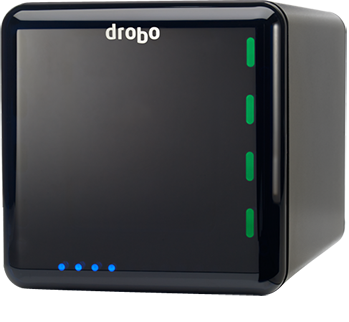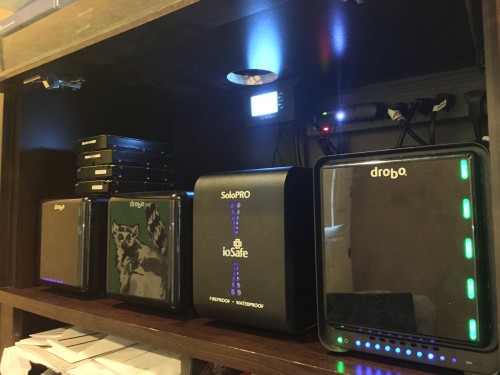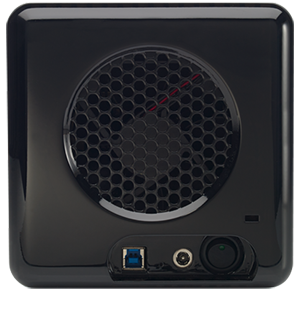I fell for the drobo the moment I heard about it, but the bloom fell from that rose after a few years. The old drobo was simply too slow for modern computers and big files. But the new third-generation drobo is enough to make you fall in love all over again: It’s a simple and relatively affordable upgrade that really delivers the goods!

Why drobo?
You’d think that someone like me who spends all day talking about high-end enterprise storage wouldn’t think much of the little drobo, but you’d be wrong. My highest respect goes to products that are perfectly suitable for their use case: SolidFire and Zerto come to mind in my “day job”, and my MacBook Pro, Miata, and Nomos Tangomat fit the bill at home. These things aren’t right for everyone, but they are perfect at doing what they do!
drobo is like that. If you need external storage at home for your photos, videos, and other files, there is no better device than a drobo. Here’s why:
- The drobo does one thing: It keeps your stuff safe. Sure there are a million other storage devices out there but they all do too little (plain hard drives) or try to do too much (Synology, etc). Home users need a device that’s dead simple to set up and leave running forever.
- The drobo is in it for the long haul: You can swap out drives to add capacity without moving a bunch of data around, you can use any old drive you happen to have, it protects from drive failure, and it includes data integrity checking to keep your data safe for years.
I set up my first drobo back in 2009 after writing about them quite a bit. It hasn’t outlasted my Model M, but I think my drobo disk pack is the oldest computer component I still use today since I switched to a Unicomp in 2012. The drobo is a veritable Ship of Theseus: the data I wrote to those drives is still accessible today, even though I’ve changed out every drive repeatedly.
This is the secret that makes the drobo special and worthwhile. Data has longevity beyond any device, and drobo is one of the few companies that recognizes this fact. It’s too bad so few enterprise storage systems have similar capability; few offer rolling components upgrades while preserving data and accessibility.
The Problems With drobo
But drobo isn’t a perfect device. For starters it’s expensive. Not as expensive as it was, and definitely a bargain for what it does, but it’s hard to convince people to shell out hundreds of dollars for longevity and data protection when they don’t value it. Most people happily risk their data with no backups or simple and cheap external hard drives then weep when they lose everything.
Connectivity could be a problem with the drobo, too. As I lamented before I got one, I wanted a shared device, not one permanently tethered to one computer. Since then, a few networked drobo devices have appeared but I don’t use them. I learned to live with one computer connected directly to a drobo, and this is probably right for most ordinary people, too.
My biggest complaint about that 2009-era drobo was performance, or lack thereof. USB2 is really slow, but the drobo was even slower. It could barely crank out 15 MB/s and IOPS were measured in single digits. The second-generation drobo added FireWire, which improved throughput somewhat but the unit was still excruciatingly slow.
On the technical side, I remain opposed to drobo’s risky drive-swap behavior. If a drive fails, or if you want to upgrade, you have to pull out the old drive and insert a new one. It then rebuilds data protection and rebalances the data, a process that takes hours and really hammers on the remaining drives. If another drive was to fail, this is when it would happen and your data would be gone.
I wish drobo had a safe disk swap mode, building dual-drive data protection when needed so you could have a little more peace of mind at this critical time. You could do this manually by enabling dual-drive data protection in the Dashboard application before swapping out a drive, but drobo should do it automatically if space allows. In fact, why not use dual-drive mode all the time as long as there is space available?
My drobo History
I moved all my critical data to a second-generation drobo back in 2009, starting with some random drives before buying a set of green Seagate and Western Digital drives. The drobo lasted through many computer swaps: MacBook Pro, iMac, Mac Mini, and Retina MacBook Pro with a Thunderbolt to FireWire adapter.
I relied on FireWire to my drobo2 for a while, but eventually added a droboS to the mix. This guy has USB3, 5 drive slots, and dual-drive redundancy. But I found it somewhat less than reliable, especially with USB3. Maybe it was my cables or maybe the droboS isn’t as good a box, but I ended up reverting to the drobo2. I even went back to USB2 connectivity for the sheer sake of convenience, leaving it connected to a USB2/3 hub.
Although the drobo houses active data, it’s never been my primary storage device. It was simply too slow for use by applications. So it became an “active archive”, with really hot data staying internal on my computer. I never used the drobo for backup, though. I’ve got a fireproof/waterproof/crushproof ioSafe Solo Pro for that. And I also added a set of plain Seagate GoFlex hard disk drives for real offline archiving in a fireproof vault.

Now For The drobo3!
While out at drobo/Connected Data for Storage Field Day 7, I mentioned that my old drobo2 was just too slow. They grabbed me a third-generation unit and asked me to give it a spin. I admit, I hadn’t been following the news and was unaware of the new device. But I took it home, swapped in my disks, and gave it a whirl.
WOW! The third-generation drobo is night-and-day faster. Using the exact same disks, it went from 15-30 MB/s to well over 100 MB/s in throughput. And a comparison of IOPS is simply unfair. I’m getting hundreds of IOPS in everyday use, making the drobo comparable to a bare drive in terms of performance. I’m still not sure I would use it for active application data, but I bet the drobo3 could keep up!
Geoff Barrall (now back in charge after merging Connected Data with drobo) told me that the company upgraded just about every component of the drobo3, but I’m betting on the CPU as the reason for this newfound performance. In the last 10 years, the mobile phone, tablet, and Internet device industry has driven amazing advances in inexpensive multi-core CPUs. I imagine one of those quad-core processors found its way into the little plastic wonder.
It’s comparable to the night-and-day performance upgrade of the Raspberry Pi 2: Moving to a quad-core CPU opens a whole new world of possibilities. I’ve got one of those on my network, too, and it’s really amazing what it can do!
In most respects, the new drobo3 is identical to the drobo2 and original 4-bay drobo. It looks the same, has the same clever drive shelves and air flow, and remains just as simple to use. But there are a few important differences:
- The third-generation 4-bay drobo now supports dual-drive data protection, reducing the risk of data loss if a drive fails or is being replaced. This feature was previously found only on the 5-or-more bay drobo devices.
- The drobo3 is USB3-only, losing the FireWire ports. This is no great loss, since most Macs lost their FireWire ports a few years back anyway. USB3 is much faster anyway, and it’s backwards compatible with USB2 if you need it.
- Somehow, the drobo3 has much better instrumentation in Drobo Dashboard, showing performance statistics and detailed drive information unavailable on previous units.
- Most importantly, the retail price for the third-generation drobo is just $299, a welcome break from the $500 or more that previous units commanded!

Teething Problems?
I have experienced some weirdness with the new drobo, however. First, it’s great that the same “disk pack” from the old drobo2 are compatible with the drobo3, but why can’t the new box swap disks with the droboS?
And speaking of swapping disks, I’ve noticed something very odd when switching disk packs: It seems that the drobo is unreliable for a few boots after a swap. When I change disk packs, it sometimes fails to boot up properly, and often “crashes” or is non-responsive after a seemingly-successful boot. But a few more boots and it “settles in” and is dead reliable from then on. I noticed this oddness when switching between my old disk pack and a new one created on the drobo3 in both directions.
It could have been due to my cables, though – I swapped these out at the same time. If you’re having similar issues with an unstable drobo, try using different/new cables or plugging it into a good USB3 hub or directly into the machine. And try rebooting a few times.
I’ve also had some issues creating new disk packs on the drobo3. Everything seemed to go fine, but the drobo refused to format the disk pack after creating it. It tried and failed to create an HFS+ filesystem after successfully creating a 16 TB thin provisioned volume. I was able to manually create it with Disk Utility, but this is concerning. Creating a Time Machine volume seemed to work fine, but I didn’t want one of those!
Finally, it seems to be impossible to create a second volume in Drobo Dashboard or to control the size of the one it creates. What if I want two 8 TB volumes? You can’t do that. The only way to create a second volume seems to be to load it up with disks larger than the existing volume. It will then prompt to create a second one. Why can’t I do that any other time?
Stephen’s Stance
I remain a huge fan of drobo generally, and the third-generation drobo remains the best choice for home storage. It’s the perfect storage device for the long haul, and the performance improvements make it a no-brainer. Get one.
If $299 is still to expensive for you, I’ve got some good news: drobo provided me with a discount code for my readers! Buy a 4-bay third-generation drobo using the code, “STEPHEN40” from www.drobostore.com and you’ll get $40 off the purchase price. If you’re in the Euro zone, head to drobo-emea.myshopify.com and use code “STEPHEN30” for a €30 discount. They sometimes run better promotions, too, so watch out for $50 or even $100 discounts!
Trying to buy it from Drobo-EMEA-shop (linked from drobo.com) but your code could not be accepted. What could be wrong?
It would be really cool to have an code for EU shop! I definitely want this device 🙂 and discount would be great to support my decision!
Thanks! I just ordered it!
The code only works in the USA shop. I’ve asked for a EU code!
Done! “STEPHEN30” gets you a €30 discount at http://drobo-emea.myshopify.com/products/drobo-4-bay
Never had the disk swap/multiple reboot phenomenon. Might really be your cabling.
You still cannot move disk packs between DAS droboes and droboes that use file services (the S2 being a go-between), I’m guessing the internal organisation is too different. When I moved centralized backup from an FS to a 3rd gen (attached to a Mini I had anyway), I made a Full copy of all backup sparsebundles to an external Usb3 disk, anyway, so that was My migration path. With the speed of the new unit that wasn’t a problem.
Just replaced my main storage Promise R4 with another 3rd gen. One of the R4 disks had died and the price of a new one came near to that of a 3rd gen (€258), and it would be completely infeasible to expand. Thunderbolt was wicked fast but I can easily life with the 130+ MB/s the Drobo offers.
IT nerds seem to be in love with Synology, often claiming they’re the only vendor in this space that “gets it right.” Should they be giving the Drobo a second look now that the 3rd gen is out?
On Windows, an alternative to Drobo is drive pooling software. (I like Drive Bender ($30), but there are at least a couple of others.) Use either an existing PC or set up a dedicated server with the hardware you want, not what Drobo limits you to. While it wouldn’t be as automatic as just popping drives in and out—you’d have to use the pool’s GUI—given how infrequently one is likely to add or remove drives from a pool I don’t see this as a real disadvantage. And Drive Bender uses NTFS so individual drives are readable outside of the pool—a huge advantage over Drobo’s proprietary file system, especially if disaster strikes. (There are lots of reports of Drobos inexplicably corrupting their pools and people who don’t have backups losing everything.)
I pulled one drive out, replaced it… and my largest drive is currently invisible on the Drobo … says to insert a disk… hopefully, after data protection… in a day or so… It will see that other drive… argh…
My drobo 5D performs great and I love the ability to upgrade by swapping a smaller drive for a larger drive and let it automatically add the extra storage. That is head and shoulders about the Windows RAID5 or even the FreeNAS that I used to run. For me, the difficulty comes when something besides a hard drive fails. It happened to me a few days ago, and there was no way to get back up and running quickly.
With Windows or FreeNAS, I could transfer the drives to another computer (or just fix the computer ) and be back up an running in under an hour. With Drobo, I have to get an RMA # , mail the device out, and wait for the replacement device to be mailed back.
The only way that I can see to alleviate the this pain point is the have a spare Drobo lying around, waiting for the failure of the primary one, or run mirrored Drobo’s That’s expensive.
Any other ideas?
For backing up a Drobo the most cost effective way is to use two large drives (let’s say 8 TB) stripped in a dual drive enclosure, for 16 TB space in this example. Striping is of course very prone to failure so it would be best to use an archival methodology with an external stripe set – meaning to leave the enclosure turned off most the time, and turning on every so often as needed. These days, programs like Time Machine and Crash Plan will automatically recognize the backup drives appearance and backup as necessary.
For the striping enclosure I would recommend the OWC Mercury at this link: http://eshop.macsales.com/item/OWC/MED3FR0GB/
8 TB archival drives (designed to be left off): http://www.amazon.com/Seagate-Archive-6GBps-Internal-ST8000AS0002/dp/B00XS423SC/ref=sr_1_1?ie=UTF8&qid=1459897963&sr=8-1&keywords=8tb+drive